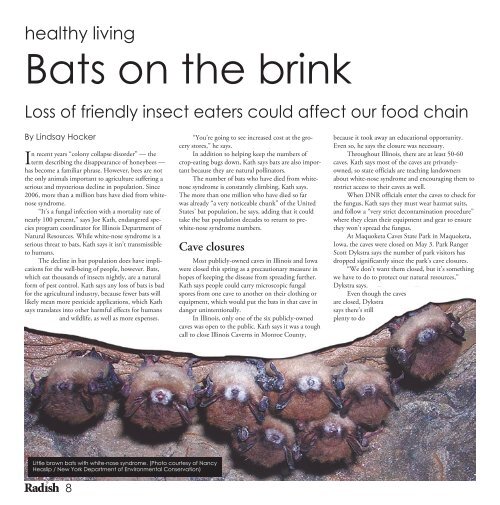August 2010 Edition - Radish Magazine
August 2010 Edition - Radish Magazine
August 2010 Edition - Radish Magazine
Create successful ePaper yourself
Turn your PDF publications into a flip-book with our unique Google optimized e-Paper software.
healthy living<br />
Bats on the brink<br />
Loss of friendly insect eaters could affect our food chain<br />
By Lindsay Hocker<br />
In recent years “colony collapse disorder” — the<br />
term describing the disappearance of honeybees —<br />
has become a familiar phrase. However, bees are not<br />
the only animals important to agriculture suffering a<br />
serious and mysterious decline in population. Since<br />
2006, more than a million bats have died from whitenose<br />
syndrome.<br />
“It’s a fungal infection with a mortality rate of<br />
nearly 100 percent,” says Joe Kath, endangered species<br />
program coordinator for Illinois Department of<br />
Natural Resources. While white-nose syndrome is a<br />
serious threat to bats, Kath says it isn’t transmissible<br />
to humans.<br />
The decline in bat population does have implications<br />
for the well-being of people, however. Bats,<br />
which eat thousands of insects nightly, are a natural<br />
form of pest control. Kath says any loss of bats is bad<br />
for the agricultural industry, because fewer bats will<br />
likely mean more pesticide applications, which Kath<br />
says translates into other harmful effects for humans<br />
and wildlife, as well as more expenses.<br />
8<br />
“You’re going to see increased cost at the grocery<br />
stores,” he says.<br />
In addition to helping keep the numbers of<br />
crop-eating bugs down, Kath says bats are also important<br />
because they are natural pollinators.<br />
The number of bats who have died from whitenose<br />
syndrome is constantly climbing, Kath says.<br />
The more than one million who have died so far<br />
was already “a very noticeable chunk” of the United<br />
States’ bat population, he says, adding that it could<br />
take the bat population decades to return to prewhite-nose<br />
syndrome numbers.<br />
Cave closures<br />
Little brown bats with white-nose syndrome. (Photo courtesy of Nancy<br />
Heaslip / New York Department of Environmental Conservation)<br />
Most publicly-owned caves in Illinois and Iowa<br />
were closed this spring as a precautionary measure in<br />
hopes of keeping the disease from spreading further.<br />
Kath says people could carry microscopic fungal<br />
spores from one cave to another on their clothing or<br />
equipment, which would put the bats in that cave in<br />
danger unintentionally.<br />
In Illinois, only one of the six publicly-owned<br />
caves was open to the public. Kath says it was a tough<br />
call to close Illinois Caverns in Monroe County,<br />
because it took away an educational opportunity.<br />
Even so, he says the closure was necessary.<br />
Throughout Illinois, there are at least 50-60<br />
caves. Kath says most of the caves are privatelyowned,<br />
so state officials are teaching landowners<br />
about white-nose syndrome and encouraging them to<br />
restrict access to their caves as well.<br />
When DNR officials enter the caves to check for<br />
the fungus, Kath says they must wear hazmat suits,<br />
and follow a “very strict decontamination procedure”<br />
where they clean their equipment and gear to ensure<br />
they won’t spread the fungus.<br />
At Maquoketa Caves State Park in Maquoketa,<br />
Iowa, the caves were closed on May 3. Park Ranger<br />
Scott Dykstra says the number of park visitors has<br />
dropped significantly since the park’s cave closures.<br />
“We don’t want them closed, but it’s something<br />
we have to do to protect our natural resources,”<br />
Dykstra says.<br />
Even though the caves<br />
are closed, Dykstra<br />
says there’s still<br />
plenty to do



